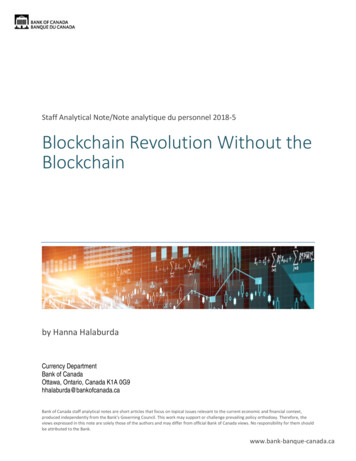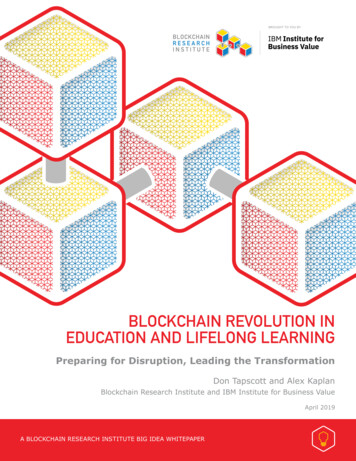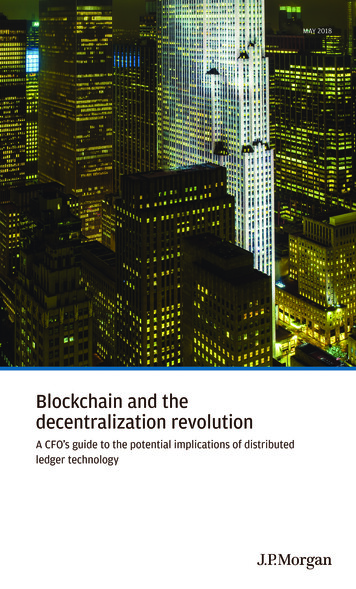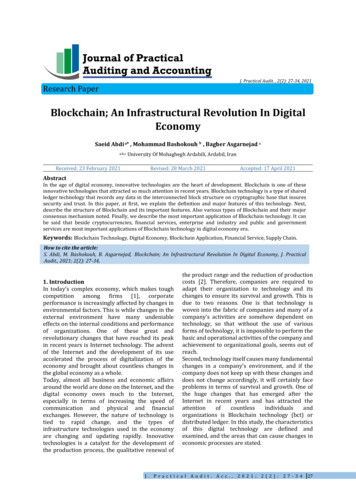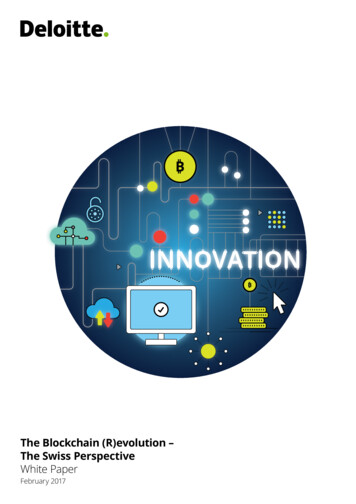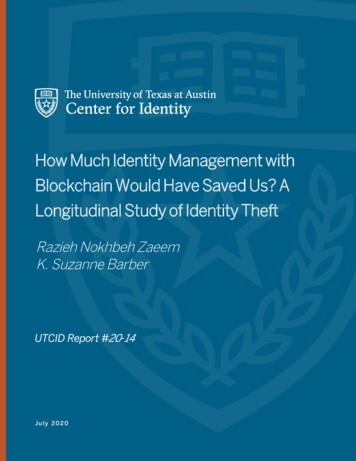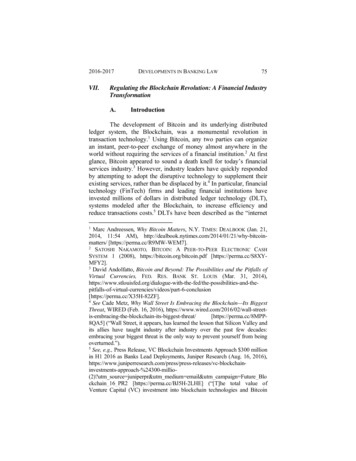
Transcription
2016-2017VII.DEVELOPMENTS IN BANKING LAW75Regulating the Blockchain Revolution: A Financial IndustryTransformationA.IntroductionThe development of Bitcoin and its underlying distributedledger system, the Blockchain, was a monumental revolution intransaction technology.1 Using Bitcoin, any two parties can organizean instant, peer-to-peer exchange of money almost anywhere in theworld without requiring the services of a financial institution.2 At firstglance, Bitcoin appeared to sound a death knell for today’s financialservices industry.3 However, industry leaders have quickly respondedby attempting to adopt the disruptive technology to supplement theirexisting services, rather than be displaced by it.4 In particular, financialtechnology (FinTech) firms and leading financial institutions haveinvested millions of dollars in distributed ledger technology (DLT),systems modeled after the Blockchain, to increase efficiency andreduce transactions costs.5 DLTs have been described as the “internet1Marc Andreessen, Why Bitcoin Matters, N.Y. TIMES: DEALBOOK (Jan. 21,2014, 11:54 AM), matters/ [https://perma.cc/R9MW-WEM7].2SATOSHI NAKAMOTO, BITCOIN: A PEER-TO-PEER ELECTRONIC CASHSYSTEM 1 (2008), https://bitcoin.org/bitcoin.pdf [https://perma.cc/S8XYMFY2].3David Andolfatto, Bitcoin and Beyond: The Possibilities and the Pitfalls ofVirtual Currencies, FED. RES. BANK ST. LOUIS (Mar. 31, cc/X35H-82ZF].4See Cade Metz, Why Wall Street Is Embracing the Blockchain—Its BiggestThreat, WIRED (Feb. 16, 2016), ma.cc/8MPP8QA5] (“Wall Street, it appears, has learned the lesson that Silicon Valley andits allies have taught industry after industry over the past few decades:embracing your biggest threat is the only way to prevent yourself from beingoverturned.”).5See, e.g., Press Release, VC Blockchain Investments Approach 300 millionin H1 2016 as Banks Lead Deployments, Juniper Research (Aug. 16, millio(2)?utm source juniperpr&utm medium email&utm campaign Future Blockchain 16 PR2 [https://perma.cc/BJ5H-2LHE] (“[T]he total value ofVenture Capital (VC) investment into blockchain technologies and Bitcoin
REVIEW OF BANKING & FINANCIAL LAW76VOL. 36of value” where “every kind of asset, from money to music, could bestored, moved, transacted, exchanged and managed, all withoutpowerful intermediaries.”6 While U.S. financial services firms areeager to supplant legacy bank infrastructure with DLTs, the industryfaces scarce regulatory guidance for combating operational andsystemic risks.7This article will evaluate the impact of distributed ledgers onthe U.S. financial industry. Section B provides a historical backgroundof how transactions have been handled before and after theintroduction of DLTs. Section C demonstrates specific DLT uses andtheir respective impacts on the U.S. financial services industry. Next,Section D examines the history of DLT regulation. Finally, Section Ereviews current proposals for regulating DLTs.B.Background1.Transactions Today: CentralizedIntermediariesIn today’s financial system, trusted, centralized intermediariesmust verify every transaction we initiate.8 For example, when using acredit card to buy goods online, merchants receive payment only aftercompanies totalled 290 million in the first 6 months of the year.”); ERNST &YOUNG, IMPLEMENTING BLOCKCHAINS AND DISTRIBUTED INFRASTRUCTURE ucture/ frastructure.pdf [https://perma.cc/3S7S-3394].6Don Tapscott, How The Blockchain Is Changing Money, TED (Aug. 2016),https://www.ted.com/talks/don tapscott how the blockchain is changingmoney and business/transcript?language en#t-218685[https://perma.cc/6XZ5-QHXV]7See Henry Engler, Blockchain Faces Maze of Regulatory Complexities,Questions and Challenges, THOMPSON REUTERS (Feb. 23 -questions-and-challenges/ [https://perma.cc/99KRU42L] (observing Charlie Cooper had no idea how R3 CEV should gainregulatory approval of their blockchain applications).8PHILLIP RAPOPORT ET AL., THE RIPPLE PROTOCOL: A DEEP DIVE FORFINANCE PROFESSIONALS 7 (2014), 0Professionals.pdf[https://perma.cc/5MH7-TAN8].
2016-2017DEVELOPMENTS IN BANKING LAW77their credit card network and bank process the transaction.9 Over 90percent of the total value of these electronic payments in the UnitedStates settle through the Automated Clearing House (ACH) Network.10ACH payments typically take one business day to process.11 Althoughthe ACH has introduced a new rule to allow same day settlement,banks will still likely “charge [consumers] a premium for processingsame-day transactions.”12Investors in the stock market must rely on the DepositoryTrust & Clearing Corporation (DTCC) to settle the “vast majority of[their] securities transactions.”13 Security transactions take at leastthree business days to settle through the DTCC.14 Since financialinstitutions do not share their internal databases detailing who ownswhich assets, intermediaries like the ACH Network and DTCC mustquery the databases of all institutions involved before clearing the9See Andrew Hinkes, Blockchains, Smart Contracts, and the Death ofSpecific Performance, INSIDE COUNS. (July 29, 2014), s-smart-contracts-and-the-death-ofspeci [https://perma.cc/PM4E-YQXZ].10Same Day ACH: Moving Payments Faster, NACHA (Sept. 13, What is ACH?: Quick Facts About the Automated Clearing House (ACH)Network, NACHA (Oct. 1, 2015), rma.cc/8QT7-RL7T].12Same Day ACH: Moving Payments Faster, supra note 10; Spencer Tierney,ACH Transfers: How They Work, NERDWALLET (Mar. 25, transfers/[https://perma.cc/AM3P-H7NB].13Guilio Prisco, DTCC and Digital Asset Holdings to Test BlockchainSolutions for the 2.6 Trillion Repo Market, BITCOIN MAG. (Mar. 30, ns-for-the-trillion-repo-market-1459358814 [https://perma.cc/QEZ9-TMJ2];DTCC, EMBRACING DISRUPTION16(2016),http://www.dtcc.com/ tps://perma.cc/4Q2S-Z4WK].14DTCC, supra note 13.
78REVIEW OF BANKING & FINANCIAL LAWVOL. 36transaction.15 The process takes time and labor, which results in fees toconsumers and merchants.162.The Future: Blockchain and DistributedLedger TechnologyIn contrast, parties who transact in Bitcoin share a singlepublic database of real-time ownership of assets—the Blockchain17—so reliance on costly, time-consuming intermediaries to confirm title(here, a party’s Bitcoin balance) and to settle transactions isunnecessary.18 Anyone can access the real-time history of transactionson the Blockchain.19 The master ledger is constantly replicated acrossa network of computers, so there is “no central database that can behacked.”20 For every transaction, “a record of the change in ownershipis immediately inscribed on the [B]lockchain, and payment andsettlement of the trade occur simultaneously.”21 The Blockchain’scryptography prevents retroactive modifications to the transaction15Marco A. Santori, Why Cos. Must Pay Attention to Delaware’s BlockchainPlan, LAW360 (May 19, 2016, 11:23 AM), ://perma.cc/385V-5G7M].16See RAPOPORT ET AL., supra note 8, at 37 (“In the current paymentsecosystem, merchants pay a fee for accepting electronic payments called themerchant discount rate (MDR).”).17“A blockchain is a ledger of transactions between parties on a network. Thedifference between a blockchain and a traditional database is that the ledger is‘distributed.’ That is, each party on the network maintains a complete copy ofthe same ledger. The parties all participate collectively in the validation andrecordation of transactions on the ledger via a computerized consensusprotocol.” Santori, supra note 15.18Id.19Kevin Petrasic & Matthew Bornfreund, Beyond Bitcoin: The BlockchainRevolution in Financial Services, WHITE & CASE (Mar. 7, rvices [https://perma.cc/7HK7-8ENK].20Jonathan Chevreu, Bitcoin and Blockchain Could be the Start of a BiggerRevolution than the Internet Itself, FIN. POST (May 6, //perma.cc/7HK7-8ENK].21Petrasic & Bornfruend, supra note 19.
2016-2017DEVELOPMENTS IN BANKING LAW79database.22 Most importantly, the Blockchain removes the need to trustintermediaries like private banks and central banks in verifyingtransaction data because “information regarding each transaction istransparently held in a digitally shared database in the cloud.”23The Blockchain does have its limitations, since it is onlydesigned to record the movement of a single asset type: Bitcoins.24 Asa result, FinTech firms have looked beyond Bitcoin to developdistributed ledgers capable of transferring currencies,25 securities,26and digital assets27 using the underlying framework of the Blockchainas a model. As an alternative to public DLTs28 like the Blockchain,developers have also created private29 and consortium DLTs.30 DLTs22Richard Lumb, Downside of Bitcoin: A Ledger That Can’t Be Corrected,N.Y. TIMES: DEALBOOK (Sept. 9, 2016), -be-corrected.html [https://perma.cc/Q5AZ-BP9M].23Barry Libert et al., How Blockchain Technology Will Disrupt FinancialServices Firms, KNOWLEDGE@WHARTON (May 24, 2016), s/ [https://perma.cc/M4X7-KAXE].24See Carlo R.W. de Meijer, Blockchain, Distributed and Shared Ledger,Permissionless and Permissioned, LINKEDIN: PULSE (Apr. 15, 2016).25See XRP Portal, RIPPLE (Sept. 25, 2016), VW-5ZLY].26See Press Release, Nasdaq Linq Enables First-Ever Private SecuritiesIssuance Documented with Blockchain Technology, Nasdaq (Dec. 30, seid 948326[https://perma.cc/7T6L-N88E].27See Raunaq Vaisoha, Colu Launch Taps Bitcoin Blockchain to DigitizeAssets, Starting with Music, COIN TELEGRAPH (Aug. 12, with-music [https://perma.cc/7QDJ-V67V].28A public DLT is one “that anyone in the world can read, anyone in theworld can send transactions to and expect to see them included if they arevalid, and anyone in the world can participate in the consensus process—theprocess for determining what blocks get added to the chain and what thecurrent state is.” Vitalik Buterin, On Public and Private Blockchains,ETHEREUM BLOG (Aug. 7, 2015), private-blockchains/ [https://perma.cc/N87S-MCK2].29Private DLTs are those “where write permissions are kept centralized to oneorganization. Read permissions may be public or restricted to an arbitraryextent. Likely applications include database management, auditing, etcinternal to a single company, and so public readability may not be necessaryin many cases at all, though in other cases public auditability is desired.” Id.
REVIEW OF BANKING & FINANCIAL LAW80VOL. 36provide many advantages over traditional transaction systems, namely:“security, transparency, full life-cycle transaction history, real-time[transactions], immutability and cost efficiency.”31The appeal of distributed ledgers is also apparent whenconsidering the transaction costs of today’s financial industry.32Santander InnoVentures33 estimates using DLTs to facilitate crossborder payments, securities trading, and regulatory compliance couldsave the financial sector up to 20 billion per year by 2022.34However, whether FinTech startups will replace historical financialservice leaders, or if the leading financial service firms willsuccessfully adapt DLTs to their current business models, is stillunclear.35 Some believe it is only a matter of time before “broaderfinancial services and banking industries [will] shift to [B]lockchainand network-based approaches.”36C.Potential Uses and Impacts of DLTsThe following subsections introduce and discuss the impact ofthree potential DLT uses: (1) reducing costs in cross-border payments,(2) providing the technological backbone for self-executing “smartcontracts,” and (3) improving regulatory compliance.30Consortium DLTs are those “where the consensus process is controlled by apre-selected set of nodes; for example, one might imagine a consortium of 15financial institutions, each of which operates a node and of which 10 mustsign every block in order for the block to be valid.” Id.31LORY KEHOE ET AL., DELOITTE, BLOCKCHAIN: DISRUPTING THE FINANCIALSERVICES INDUSTRY? 2 (2015), Documents/FinancialServices/IE Cons Blockchain 1015.pdf[https://perma.cc/D584-GCW6].32MARIANO BELINKY, SANTANDER, THE FINTECH 2.0 PAPER: REBOOTINGFINANCIAL SERVICES 15 (2015), /2015/06/The-Fintech-2-0-Paper.pdf [https://perma.cc/TZ37S5JE].33Santander InnoVentures is a fund which primarily invested “disruptiveinnovat[tors] in the FinTech space.” SANTANDER INNOVENTURES,http://santanderinnoventures.com/ [https://perma.cc/U3Y6-AXVC].34Id.35See Libert, supra note 23.36Id.
2016-2017DEVELOPMENTS IN BANKING LAW1.81Reduced Costs in Cross-Border PaymentsOne of the groundbreaking uses of DLT is its ability tofacilitate inexpensive cross-border payments.37 To transfer paymentsoverseas, banks currently maintain foreign currency reserves incorrespondent accounts in overseas banks.38 When a bank has nocorrespondent account in the terminal country, it must use costlyintermediary banks to broker the transaction.39 Most banks rely on theSwift network40 to facilitate their cross-border transactions in a“secure, standardized and reliable environment.”41At the center of improving cross-border payments with DLT isFinTech start-up Ripple.42 Ripple uses DLT to allow banks andpayment networks to send real-time, cross-border payments.43 Rippleremoves the need for banks to maintain capital-intensivecorrespondent accounts in overseas banks.44 Ripple’s public algorithm“automatically matches . . . payment with the best-possible FX37See Lori Ciavarella, For Cross-Border Payments, Blockchain Is Like“Email for Money,” PAYTHINK (June 24, 2016), ney-3024465-1.html [https://perma.cc/6NZ2-V8MW].38Fernando L. Aenlle-Rocha, Correspondent Banking After September 11,L.A. L. 27 (Sept. 2002).39See Beneficiary Banks, Intermediary/Corresponding Banks, and AssociatedFees, AIARC (2016), spondent-Banks-and-Associated-Fees [https://perma.cc/388N-THVY].40“Swift provides a network that enables financial institutions to send andreceive information about financial transactions in a secure, standardized andreliable environment. The majority of banks use the Swift network to sendmoney. As of September 2010, more than 9,000 financial institutions in 209countries, were sending and receiving an average of over 15 million messagesper day, compared with just 2.4 million a day in 1995.” Chris Skinner, Willthe Blockchain Replace Swift?, AM. BANKER (Mar. 8, -the-blockchain-replaceswift-1079740-1.html [https://perma.cc/7D5J-JZBM].41Id.42See Elliot Maras, Ripple: It’s Time for a Blockchain Cross-Border PaymentNetwork, CRYPTOCOINS NEWS (July 16, 2016), 43Ryan Zagone & Wellington Sculley, Executive Summary for FinancialInstitutions, RIPPLE (2016), financial-institutions/ [https://perma.cc/5ZR8-FAR7].44Id.
82REVIEW OF BANKING & FINANCIAL LAWVOL. 36[rate].”45 One suggested use is lowering the fees of remittances.46Using Ripple, banks can save 60 percent of their total processing costson a 500 payment, significantly increasing the amount of moneyavailable to remittance recipients.47Some believe Ripple’s distributed ledger could eventuallyreplace the Swift network for interbank payments.48 Morgan Stanleyhas stated that adopting a Ripple-like payment system could “shortensettlement periods, speed up transactions and reduce the risk offraud.”49 Morgan Stanley considers Ripple to be a leading internationalpayment alternative to Swift.502.Self-Executing “Smart Contracts”Another highly touted DLT innovation is the smart contract.51Ethereum, a well-known leader in smart contracts, allows users toexecute transactions based on messages transferred on a DLT.52 Forexample, vehicle financing companies have contemplated using smartcontracts to keep track of car finance payments.53 When a customerfails to make a timely payment, a smart contract could automatically45Id.See Use Case: Retail Remittances, RIPPLE, https://ripple.com/solutions/retail-remittances/ [https://perma.cc/BM7X-SS7B] (“Ripple’s fee predisclosure, status tracking and payment confirmation enables banks to providea low-cost remittance service to attract new clients with an improvedcustomer experience.”).47Id.48Skinner, supra note 40.49MORGAN STANLEY, GLOBAL INSIGHT: BLOCKCHAIN IN BANKING:DISRUPTIVE THREAT OR TOOL? 6 (2016), 0Id.51See Josh Stark, Making Sense of Blockchain Smart Contracts, COINDESK(June 4, 2016), ts/[https://perma.cc/A7LA-Y86L].52See Paul Vigna, BitBeat: Ethereum Opens Its ‘Frontier’ for Business,WALL ST. J.: MONEYBEAT (July 31, 2015, 3:19 PM), perma.cc/H2FX-6GZE].53See Peter Coy & Olga Kharif, This Is Your Company on pany-on-blockchain[https://perma.cc/554B-K7XE].46
2016-2017DEVELOPMENTS IN BANKING LAW83transfer title back to the financing company and prevent a vehicle fromstarting.54 In the future, smart contracts could eliminate the need forfinancial clearing houses and escrow agents because financial marketscould trade “fully-digital assets across blockchain networks, with theterms of those trades enforced by code.”553.Improving Regulatory ComplianceDistributed ledgers also have a use in improving regulatorycompliance.56 Transaction records on the ledger would “create an audittrail for regulators to verify compliance” in real time.57 For example,regulators could have used DLT records to allow for a “far prompter,better-informed and more calibrated regulatory intervention [to thefinancial crisis in 2008] instead of the disorganized response thatunfortunately ensued.”58 Financial institutions could use public ledgerhistory to significantly reduce the time dedicated to anti-moneylaundering and know-your-customer procedures when onboarding newclients.59D.Current Regulation: Virtual CurrenciesCurrently, regulation is not targeted at DLTs themselves, butrather at the use of virtual currencies on such DLTs.60 While virtualcurrencies are not necessary for a DLT to operate, they do serve a54Id.Josh Stark, How Close Are Smart Contracts to Impacting Real-WorldLaw?, COINDESK (Apr. 11, 2016), -real-world-law/ [https://perma.cc/XX9P-BM4U].56See Cliff Moyce, How Blockchain Can Revolutionize RegulatoryCompliance, CORP. COMPLIANCE INSIGHTS (Aug. 10, -Q7S7].57Id.58J. Christopher Giancarlo, Comment: With Blockchain, Regulators ShouldFirst Do No Harm, FIN. TIMES (Apr. 12, 2016), -83242733f755[https://perma.cc/NXA6NXQ6].59Moyce, supra note 56.60Eric Sibbitt et al., Blockchain and Financial Services: Hype or ry/LEXOLOGYdetail.aspx?g .cc/2FK8-E5EE].55
REVIEW OF BANKING & FINANCIAL LAW84VOL. 36variety of complementary functions.61 For instance, Ripple’s XRPcurrency: (1) operates as a bridge currency in foreign exchangetransactions,62 (2) imposes costs on ledger spamming,63 and (3) awardsactivities seen as beneficial to the distributed ledger network.64At the federal level, Financial Crimes Enforcement Network(FinCEN), the Commodity Futures Trading Commission (CFTC), andthe Internal Revenue Service (IRS) regulate virtual currencies ascurrency, commodities, and property, respectively.65 The inconsistentlegal status of virtual currencies is a barrier to DLT adoption in theUnited States because developers are unable to determine how to“transfer[] and grant[] security over interests in such assets;” judgetheir “treatment in insolvency;” or apply “insolvency protection.”66At the state level, few legislatures have adopted a regulatoryframework for virtual currencies.67 New York is at the forefrontregulating FinTech firms through its BitLicense charter, whichregulates firms dealing in virtual currencies.68 New York granted itssecond BitLicense to Ripple on June 13, 2016.69E.Future Regulation: Distributed LedgersVery little regulatory guidance exists on distributed ledgersthemselves, which are predicted to have a much “greater impact thanthe virtual currencies derived from [them].”70 The Financial Stability61See generally XRP Portal, supra note 25.Id.63Id.64Id.65The Arduous Task of Regulating Bitcoin, STRATFOR (Aug. 3, 66WORLD FED’N OF EXCHS., FINANCIAL MARKET INFRASTRUCTURES ANDDISTRIBUTED LEDGER TECHNOLOGY 6–7 (2016), e Arduous Task of Regulating Bitcoin, supra note 65.68Id.69Pete Rizzo, New York Regulators Grant Second BitLicense to Ripple,COINDESK (June 13, 2016), http://www.coindesk.com/new-york-bitlicenseripple/ [https://perma.cc/VL92-RKSD].70The Arduous Task of Regulating Bitcoin, supra note 65.62
2016-2017DEVELOPMENTS IN BANKING LAW85Oversight Council71 has noted DLTs may provide numerous benefitsto the financial services industry, but the innovation may also “pose. . . risks which market participants and . . . regulators will need tomonitor.”72 Distributed ledgers have introduced two concerns:operational risks and systemic risks.73 One example of operational riskis DLT’s susceptibility to a 51 percent attack.74 These attacks “comefrom parties who control at least 51% of the computing power that the. . . system uses to validate transactions and create the blockchain (ortransaction ledger).”75 As for systemic risk, regulators worry about thestability of the financial system as distributed ledgers “reduce theimportance of . . . centralized intermediaries.”76 Regulators concede“vulnerabilities associated with [DLTs] may not become apparent untilthey are deployed at scale.”77This lack of regulatory clarity is holding back real-world DLTimplementation in financial services.78 In a DLT world, transactionswill settle instantly without the need for centralizedintermediaries.79Therefore, regulators will need to revisitcontemporary rules, which are premised on the necessity of theseintermediaries.80 For example, DLT companies are unsure whether to71The Financial Stability Oversight Council is a department within the U.S.Treasury made up of a “collaborative body . . . bring[ing] together theexpertise of the federal financial regulators, . . . insurance expert[s] . . ., andstate regulators” to “constrain excessive risk in the [U.S.] financial system.”About FSOC, FIN. STABILITY OVERSIGHT COUNCIL ].72FIN. STABILITY OVERSIGHT COUNCIL, 2016 ANN. REP. 127 ort.pdf [https://perma.cc/X9EW-Z4Q4].73See Angela Watch, The Bitcoin Blockchain As Financial MarketInfrastructure: A Consideration of Operational Risk, 18 N.Y.U. J. LEGIS. &PUB. POL’Y 837, 854 (2015).74Id. at 861.75Id.76FIN. STABILITY OVERSIGHT COUNCIL, supra note 72.77See id.78See Huw Jones, Exchanges Call for Regulatory Clarity over BlockchainUse, REUTERS (Aug. 25, 2016), ons-blockchain-idUSKCN11017Q [https://perma.cc/NGD6-4DMC].79See Engler, supra note 7.80FIN. STABILITY OVERSIGHT COUNCIL, supra note 72.
86REVIEW OF BANKING & FINANCIAL LAWVOL. 36apply the “settlement finality”81 rules of the Securities ExchangeCommission (SEC) or the CFTC.82In response to regulatory uncertainty, Congress and federalagencies are currently considering four competing regulatoryproposals: (1) sandbox regulation, (2) do no harm and principles-basedregulation, (3) regulation by a single, centralized agency authority, and(4) regulation by federal charter.831.Sandbox Regulation and The Do No HarmApproachIn a move to prevent a loss of FinTech business to the UnitedKingdom’s “sandbox” regulatory regime, U.S. House RepresentativePatrick McHenry introduced a bill proposing an American sandboxapproach to regulating FinTech firms in September 2016.84 Sandboxstyle regulation would allow DLT firms to work side-by-side withregulators to “test a new product or business model with a limitedlaunch, without going through the full regulatory process.”85 The billcalls for several federal agencies to establish “Financial ServicesInnovation Offices” within their respective agencies, which wouldwork in concert to approve FinTech products and services.86Innovators would need to prove to regulators that their product servesa public interest, improves access to financial products or services, anddoes not pose systemic risk to consumers or the financial system.87A sandbox approach would allow DLT developers to requestchanges to existing rules at any participating agency.88 Sandbox81Santori, supra note 15 (“Settlement finality refers to the point in time wherethe definitive transfer of ownership—not merely custody—occurs betweenparties to a transaction. Practically, it is the point at which settlementinstructions are irrevocable and the transaction becomes irreversible.”).82Engler, supra note 7.83See infra notes 86, 94, 99, 114 and accompanying text.84Financial Services Innovation Act of 2016, H.R. 6118, 114th Cong. (2016);Rachel Witkowski, U.S. House Bill Aims to Set Up ‘Sandbox’ for FintechInnovation, WALL. ST. J. (Sept. 22, 2016), ttps://perma.cc/QW7M-3WZM].85Witkowski, supra note 84.86Id.87Id.88Elizabeth Dexheimer, Every Regulator Gets a Piece of Fintech UnderLawmaker’s Plan, BLOOMBERG (Sept. 22, 2016), http://www.
2016-2017DEVELOPMENTS IN BANKING LAW87regulation also ensures regulators would stay in sync with the pace ofnew DLT products.89 However, a multi-agency approach to regulationhas proven to be difficult in the past, as evidenced by the slow pace ofrulemaking by multiple agencies for the Dodd-Frank Act.90 DLTproponents are concerned industry “popularity could overwhelm . . .regulators,” further delaying the approval process.912.Do No Harm: Principles-Based ApproachCFTC Commissioner J. Christopher Giancarlo has endorsed aregulatory model somewhat similar to sandbox regulation—the “do noharm” approach.92 Giancarlo believes the “do no harm” approach tothe Internet, where the U.S. government allowed the private sector totake the lead in early innovation, would serve as a good model fordistributed ledger adoption.93 Under this regulatory framework,companies would “not have to seek government’s permission, only itsforbearance, to develop DLT [products] . . . .”94 However, Giancarlogoes a step further than sandbox regulation by calling uponcooperation between U.S. and international regulatory bodies toformulate principle-based rules to provide “flexibility, certainty andharmonization necessary for [DLT] to flourish.”95 Under principlebased regulation, regulators would forgo “rigid application of existingrules designed for a bygone technological era” and foster a“predictable, consistent and straightforward legal environment . . . .”for DLT maker-s-plan , supra note 84.92See J. Christopher Giancarlo, Commissioner, Commodities Futures TradingComm’n, Special Address Before the Depository Trust & ClearingCorporation 2016 Blockchain Symposium: Re
VII. Regulating the Blockchain Revolution: A Financial Industry Transformation A. Introduction The development of Bitcoin and its underlying distributed ledger system, the Blockchain, was a monumental revolution in transaction technology.1 Using Bitcoin, any two parties can organize an instant, peer-to-peer exchange of money almost anywhere in the


